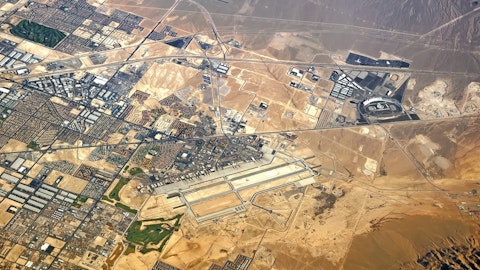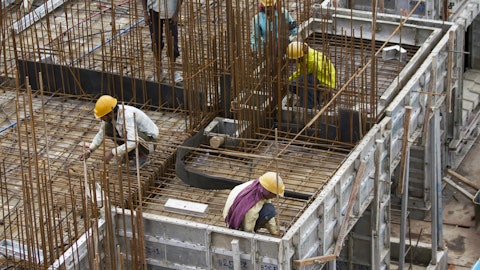In EMEA, despite a challenging demand environment, EBITDA continues to grow, while margin expanded to the highest level in several years. This performance was largely anchored by another quarter of solid results in Europe. EBITDA in Europe rose 17%, while margin increased 2.6 percentage points to a record high of 17.3%. In a quarter where European volumes declined double-digits, these achievements speak to the success of our One Europe strategy implemented in 2019, where we consolidated and integrated our value chain footprint, accelerated our climate action efforts, while rationalizing cost and pursuing bolt-on growth investments in integrated urban micro markets. The most recent examples of our growth investment strategy are the purchase of aggregate quarries near Madrid that will bolster our reserves in this fast-growing metropolis and the acquisition of [Indiscernible], a Motors and Adhesives technological leader that serves the German, French, Polish, and Czech Republic markets.
Pricing in Europe remained resilient with cement prices up 21% commensurate with the still elevated input cost inflation environment, while prices were flat sequentially. Ready-mix and aggregate prices also showed significant growth, but declined slightly sequentially due to geographic mix. While European construction demand is currently challenging, we remain optimistic over the regions, medium-term prospects as Europe pivots decisively towards a more circular economy and construction is supported by multibillion euro projects related to green renovation, transportation, climate spend, energy reconfiguration, and onshoring investment opportunities. EBITDA from Asia, Middle East, and Africa increased low single-digits, while margins contracted by 1.2 percentage points, primarily due to the competitive environment in the Philippines.
As Fernando mentioned, we are deeply saddened by the recent events in Israel and the Middle East and we remain focused on supporting our employees and communities during these challenging times and keeping them as safe as possible. Net sales and EBITDA in the South Central America and Caribbean region rose 11% and 18%, respectively, driven primarily by prices and slowing energy inflation. Margin improved one percentage point with a slight decline in sequential margin, largely explained by higher maintenance. Regional cement prices rose high single-digits. Despite continued pressure in bag cement in the region, volumes grew for the first time in two years, driven largely by positive performance in Panama, the Dominican Republic and Jamaica. Demand has been supported by formal construction related to infrastructure projects, such as the Bogota Metro, the fourth bridge over the canal in Panama and [Indiscernible] related projects in the Dominican Republic and Jamaica.
And now I will pass the call to Maher to review our financial development.
Maher Al-Haffar: Thank you, Lucy, and good day to everyone. We are very pleased with our performance this year, with EBITDA growing at an increasing rate for three consecutive quarters. EBITDA grew 40% on a reported basis and 32% on a like-to-like, reaching the highest third quarter in recent times and growing at 2.5 times sales growth. This performance was achieved through three levers. First, is the successful execution of our robust pricing strategy across our businesses and markets. The second, contributions from our growth strategy and urbanization solutions. And lastly, decelerating input cost inflation, coupled with cost efficiency measures. With respect to slowing inflation, fuels and electricity for the production of cement are the most important contributors.
We have seen year-over-year growth rates in unitary fuel costs decelerate for four consecutive quarters. In the third quarter, we saw unitary fuel costs reversed for the first time since the inception of the Ukraine War and declined by 5% versus the prior year. Unitary electricity costs rose 10% in the third quarter, the lowest growth rate in eight quarters. In the context of our sustainability agenda as well as our strategy to lower the volatility of our fuels, we continue to expand the use of alternative fuels, which are significantly less expensive than non-renewables and an important source of biomass. Year-to-date, free cash flow after maintenance CapEx of almost $700 million was $535 million higher than the same period last year, primarily due to higher EBITDA and lower investment in working capital, which was partially offset by higher taxes.
The increase in cash taxes is a consequence of stronger results as well as the tax effect of foreign exchange on our US dollar-denominated debt. Working capital days stood at minus two, two more days on a year-over-year basis, but importantly, improving by two days sequentially driven primarily by inventories. We expect to further reduce our working capital investment as supply chain challenges normalize. After adjusting for an extraordinary gain from the sale of assets in the prior year, net income declined approximately $130 million due to the higher taxes as discussed previously. During October, we successfully completed two transactions aimed at further streamlining our debt maturity profile and diversifying our sources of funds. First, on October 30th, we expect to close the refinancing of our syndicated bank facility, consisting of a $1 billion term loan and a $2 billion committed revolving credit facility.
This represents an increase of $250 million in our revolver and a reduction of $500 million in our term loan. Final maturity under the syndicated bank facility is now 2028. We are pleased that in a volatile market where yields have been rising to be able to maintain terms and conditions, including the pricing grid established in 2021 as well as being able to increase our committed revolver. Second, in early October, we’ve taken advantage of our recent upgrade in our credit ratings. We issued $6 billion the peso-denominated sustainability-linked long-term notes in Mexico, the equivalent of approximately $335 million in three and seven-year tranches, which were then swapped into dollars, achieving a US dollar cost approximately 130 basis points below our dollar curve.
This was the first time in 15 years that we tapped the Mexican debt capital markets. The book was oversubscribed by 2.5x. Proceeds were used to reduce exposure under our bank facility. On the slide, you can see our debt maturity profile as of the end of the third quarter, pro forma for the refinancing of our bank facility and the issuance of the notes in Mexico. As you can see, we now have a flatter debt maturity profile with no significant maturities in any year, and with an average life of five years. I expect our free cash flow after maintenance CapEx generation should be sufficient to meet our maturities in any given year. Leverage at the end of the quarter stood at 2.16 times with a trailing 12 months EBITDA of $3.2 billion. This is the third consecutive quarter of declining leverage and the lowest leverage in recent times.
These transactions, along with our improved performance and continued declining leverage should continue to pave the way to reaching investment grade. And now back to you, Fernando.
Fernando Gonzalez: Based on our strong results year-to-date, we are improving our 2023 EBITDA guidance from $3.25 billion to in excess of $3.3 billion, representing at least a 23% increase versus 2022. As always, our guidance is based on the foreign exchange rates in effect at the time of guidance, in this case, as of the end of September. As we look forward, we are confident that despite softer volume outlooks in several markets, our pricing strategy will be successful in reflecting current input cost inflation. We also expect that absent a major macro shock, we should continue to experience a more refined input cost backdrop than that of the past two years. For CapEx, we now expect a total of $1.35 billion with $900 million for maintenance and $450 million for strategic.
For working capital, we now expect an investment of $100 million. Finally, we are increasing our cash tax guidance to $550 million, driven by the tax effect of a stronger peso on debt and by better results primarily from Mexico. We have made some adjustments in regional volume guidance, which you can find detailed in the appendix. And now back to you, Lucy.
Lucy Rodriguez: Before we go into our Q&A session, I would like to remind you that any forward-looking statements we make today are based on our current knowledge of the markets in which we operate and could change in the future due to a variety of factors beyond our control. In addition, unless the context indicates otherwise, all references to pricing initiatives, price increases or decreases refer to prices for our products. And now we will be happy to take your questions.
A – Lucy Rodriguez: In the interest of time and to give other people an opportunity to participate, we kindly ask that you limit yourself to only one question. [Operator Instructions] And the first question comes from Carlos Peyrelongue from Bank of America. Carlos?
Carlos Peyrelongue: Thank you, Lucy. Congratulations on the strong results. My question is related to US volumes. If you could comment on your outlook for residential, commercial, and infrastructure for next year, just some general views as to what you see as the drivers and the risks for next year would be very helpful. Thank you.



